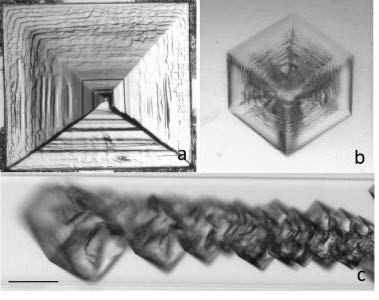 Back to Open Positions & Projects
Back to Open Positions & Projects

How does the confinement size affects the mechanism of cubic to hopper growth transition of NaCl?
- Supervisor: Noushine Shahidzadeh, Daniel Bonn
- Project Type: Master Project
- Goal: To understand the different crystallisation types of NaCl.
- Info: Send email to: N.Shahidzadeh or call: +31(0) 20 525 8261
- PDF: Click here for PDF
Salt crystallization is a key factor in many industrial and natural processes such as food industry , pharmacology , biomineralization, in oil well drilling, in the erosion of rocks, monuments and sculptures and for the sodification of soils. Understanding how crystal shapes come about is of considerable importance for all these processes. Crystals generally are rarely found only in their equilibrium state; instead, many minerals and salts appear as clusters of interconnected crystalline regions known as hopper crystals. The latter results from an anisotropic growth in which the edges of a crystal grow faster than the centers of its faces.
In this project , we focus on sodium chloride, the most abundant salt on earth and present in various applications . As an example, NaCl is the main seasoning ingredients on food industry and the control over the crystal structure is an important variable to consider as a strategy to reduce sodium reduction while maintaining salt intensity and saltiness perception in the food. Equilibrium NaCl crystals are well known to have a cubic shape however, other shapes are also often encountered (Fig. 1). Most of the reported hopper forms of sodium chloride in the literature are hollow cubes, pyramid shapes or show a skeletal hopper growth. However, the transition from cubic to the different hopper growths modes is still ill understood as the kinetics of crystal growth depends on important parameters such as the supersaturation and total solution volume.
In the project we will perform experiments on NaCl crystallization from solutions at the microscale (in microcapillaries of different sizes ranging from 5 to 100 um), under controlled evaporation conditions. Confinement and small volumes can significantly stabilize metastable phases and allow for the selection of specific crystal/polycrystalline structures and crystal orientations. The supersaturation at the onset of nucleation as well as the morphology of the crystal and its speed of growth will be measured by direct visualization using a rapid camera connected to an optical microscope.
The project aims to bring answers to the following questions:
1 - What is the impact of the volume of the solution and the size of the confinement on the transition from cubic to hopper growth?
2 - Under what conditions does the morphology of the hopper growth change from skeletal growth to hollow cubes?
3 - Can a theoretical model of diffusion-limited growth describe the kinetics of the growth observed experimentally?
